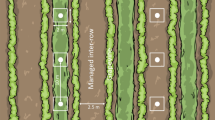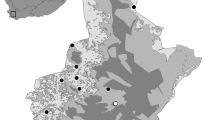Abstract
Vincetoxicum rossicum is an invasive alien vine introduced from Europe in the late 1800s that is now an emerging pest in upstate New York and eastern Ontario. The plant can form dense, monotypic stands in woodlots and old fields, and may be displacing native vegetation. As a consequence, V. rossicum may be displacing arthropod fauna associated with native vegetation. In June and August 2002, we sampled V. rossicum and three other old field plants (Asclepias syriaca, Solidago altissima, and mixed graminoids) for arthropods using pitfall traps and by sampling individual plants. A total of 7868 arthropods were counted on plants and 18,195 individuals were trapped; these were sorted by feeding guild. Overall, stands of V. rossicum supported the lowest abundance of both stem- and ground-dwelling individuals, as well as the lowest number of arthropods in most phytophagous guilds. Some feeding guilds are entirely absent: V. rossicum stands are completely devoid of gall-makers and miners, and support few pollinators. This study suggests that arthropod diversity will decline if V. rossicum displaces native old-field plants.
Similar content being viewed by others
References
AA Agrawal PM Kotanen (2003) ArticleTitleHerbivores and the success of exotic plants: a phylogenetically controlled experiment Ecology Letters 6 712–715 Occurrence Handle10.1046/j.1461-0248.2003.00498.x
RH Arnett SuffixJr (2000) American Insects: A Handbook of the Insects of America North of Mexico CRC Press Florida
DJ Borror CA Tripplehorn NF Johnson (1989) An Introduction to the Study of Insects EditionNumber6 Saunders College Publishing New York
M Capo JM Saa (1989) ArticleTitle(–)-Antofine: a phenanthroindolizidine from Vincetoxicum nigrum Journal of Natural Products 52 389–390 Occurrence Handle10.1021/np50062a030 Occurrence Handle1:CAS:528:DyaL1MXitV2gtLs%3D
MJ Crawley (1986) ArticleTitleThe population biology of invaders Philosophical Transactions of the Royal Society of London B 314 711–731
SC Digweed CR Currie HA Carcamo JR Spence (1995) ArticleTitleDigging out the ‘digging-in effect’ of pitfall traps: influences of depletion and disturbance on catches of ground beetles (Coleoptera: Carabidae) Pedobiologia 39 561–576
DiTommaso A, Lawlor FM and Darbyshire SJ (in press) Biology of Canadian weeds: Vincetoxicum rossicum (Klepow) Barbar. (syn. Cynanchum rossicum (Klepow) Borhidi) and Vincetoxicum nigrum (L.) Moench (syn. Cynanchum louiseae (L.) Kartesz & Gandhi). Canadian Journal of Plant Science
RM Keane MJ Crawley (2002) ArticleTitleExotic plant invasions and the enemy release hypothesis Trends in Ecology and Evolution 17 164–170 Occurrence Handle10.1016/S0169-5347(02)02499-0
M Kirk (1985) ArticleTitleVincetoxicum spp. (dog-strangling vines): alien invaders of natural ecosystems in southern Ontario The Plant Press 3 IssueID4 130–131
C Lumer SE Yost (1995) ArticleTitleThe reproductive biology of Vincetoxicum nigrum (L) Moench (Asclepiadaceae), a Mediterranean weed in New York State Bulletin of the Torrey Botanical Club 122 IssueID1 15–23
RN Mack (2000) Assessing the extent, status, and dynamism of plant invasions: current and emerging approaches HA Mooney RJ Hobbs (Eds) Invasive Species in a Changing World. Island Press Washington, DC 141–168
JD Majer (1978) ArticleTitleAn improved pitfall trap for sampling ants and other epigaeic invertebrates Journal of the Australian Entomological Society 17 261–262
SB Malcolm (1991) Cardenolide-mediated interactions between plants and herbivores GA Rosenthal MR Berenbaum (Eds) Herbivores: Their Interactions with Secondary Plant Metabolites, VII: The Chemical Participants Academic Press San Diego, CA 251–296
J McNeill (1981) ArticleTitleTaxonomic, nomenclatural and distributional notes on Canadian weeds and aliens Le Naturaliste Canadien 108 237–244
CE Mitchell AG Power (2003) ArticleTitleRelease of invasive plants from fungal and viral pathogens Nature 421 625–627 Occurrence Handle10.1038/nature01317 Occurrence Handle1:CAS:528:DC%2BD3sXovFKnsQ%3D%3D Occurrence Handle12571594
IM Parker D Simberloff WM Lonsdale K Goodell M Wonham PM Kareiva MH Williamson B Von Holle PB Moyle JE Byers L Goldwasser (1999) ArticleTitleImpact: toward a framework for understanding the ecological effects of invaders Biological Invasions 1 3–19 Occurrence Handle10.1023/A:1010034312781
RB Root N Cappuccino (1992) ArticleTitlePatterns in population change and the organization of the insect community associated with goldenrod Ecological Monographs 62 393–420
MJ Samways PM Caldwell R Osborn (1996) ArticleTitleGround- living invertebrate assemblages in native, planted and invasive vegetation in South Africa Agriculture Ecosystems and Environment 59 19–32 Occurrence Handle10.1016/0167-8809(96)01047-X
SAS Institute, Inc (1995) JMP Statistics and Graphics Guide: Version 3. Cary, NC, 593 pp
SE Sheeley DJ Raynal (1996) ArticleTitleThe distribution and status of species of Vincetoxicum in eastern North America Bulletin of the Torrey Botanical Club 123 IssueID2 148–156
M St Denis N Cappuccino (2004) ArticleTitleReproductive biology of Vincetoxicum rossicum (Kleo.) Barb. (Asclepiadaceae), an invasive alien in Ontario Journal of the Torrey Botanical Society 131 8–15
RJ Toft RJ Harris PA Williams (2001) ArticleTitleImpacts of the weed Tradescantia fluminensis on insect communities in fragmented forests in New Zealand Biological Conservation 102 31–46 Occurrence Handle10.1016/S0006-3207(01)00091-X
L Pijl Particlevan der (1961) ArticleTitleEcological aspects of flower evolution: II. Zoophilous flower classes Evolution 15 44–59
LM Wolfe (2002) ArticleTitleWhy alien invaders succeed: support for the escape-from-enemy hypothesis American Naturalist 160 705–711 Occurrence Handle10.1086/343872
Author information
Authors and Affiliations
Corresponding author
Rights and permissions
About this article
Cite this article
Ernst, C.M., Cappuccino, N. The effect of an invasive alien vine, Vincetoxicum rossicum (Asclepiadaceae), on arthropod populations in Ontario old fields. Biol Invasions 7, 417–425 (2005). https://doi.org/10.1007/s10530-004-4062-4
Received:
Accepted:
Issue Date:
DOI: https://doi.org/10.1007/s10530-004-4062-4




